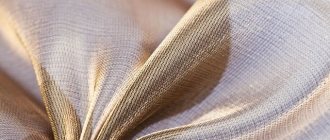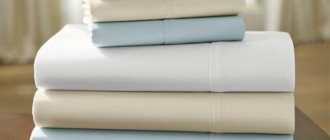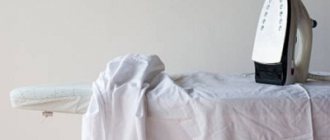The question of whether bed linen should be ironed after washing is controversial to this day. And although this is a rather labor-intensive process that takes a lot of effort and free time, it has supporters. Also, according to recent studies, it has been established that iron and starch have a negative effect not only on the fabric from which sleepwear is made, but also on the health of the person using it.
Therefore, everyone will have to decide for themselves whether it is worth ironing washed bedding. Let us further consider the existing pros and cons of this process so that you can make a final decision.
Reasons why you need to iron your bed linen after washing
Housewives still prefer to always use an iron for some household items, and there are several reasons for this:
- Processing products at high temperatures allows you to destroy dust mites and their larvae, as well as many microbes and bacteria. When washing at temperatures up to 60°C, this task is impossible.
- After ironing, the wear resistance of cotton fabric increases due to the straightening of its fibers.
- Clean, wrinkle-free bed linen looks fresh and tidy.
- Ironed bedding can be rolled up more compactly, and thanks to this, it can be easily laid out on shelves in the closet, while saving space.
- During the process of hot ironing, the fabric becomes softer, which allows a person to experience the pleasure of improved tactile sensations during a night's sleep. After all, lying in a clean bed after a hard day of work is considered true pleasure for many.
Advice: it never hurts to have a spare set of bed linen on hand, then you can always offer it to dear guests who suddenly decide to spend the night with you.
Reasons why it can be used immediately after drying
Even taking into account the advantages described above, it should be noted that the ironing process is fraught with several disadvantages, namely:
- The procedure is very tiring and takes a lot of time, effort, and electrical energy.
- The pleasant aroma that appears after washing with fabric softener instantly disappears under the influence of high temperatures.
- A number of tests conducted by American scientists have shown that ironing reduces the hygroscopic properties of fabric (especially satin or silk). The material begins to poorly absorb the liquid that the human body naturally releases at night. This can lead to serious health problems.
- Certain materials from which bedding is made accumulate static electricity when ironed with a hot iron. This property can contribute to the appearance of unpleasant sensations (restlessness or increased fatigue) during sleep.
This is interesting: psychologists from Europe conducted several experiments, during which it was found that people who prefer to sleep on ironed sheets are very vindictive, conflict-ridden, and do not take criticism well. In addition, their intimate life is more boring and monotonous than that of those who do not iron their clothes.
When you can’t do without using an iron
There are a few exceptions when the procedure is necessary:
- Bedding for children under 3 months of age. Experts strongly recommend that you pay attention to this process, because even the slightest folds in the sheet can seriously injure the baby’s delicate skin.
- People suffering from various skin diseases (lichen, dermatitis or fungus) must have a separate set of bed linen and towels, which must be washed frequently, and then ironed and steamed.
Advice: it is better to discuss the question of whether there is a need to iron a newborn’s linen with a pediatrician.
Ironing rules
If you are sure that ironing is really necessary, follow the simple rules given below. Thanks to them, you will not only facilitate this process, but also significantly speed it up:
- It is better to iron delicate fabrics slightly damp, from the inside out. This will make smoothing out seams and folds easier and faster. Strictly observe the temperature regime of the iron for a particular type of material.
- Cotton fabric is not afraid of heat, so feel free to set the maximum mode, ironing the fabric from the front side. A household appliance with a steaming function will allow you to carry out the procedure more efficiently.
- It is not recommended to immediately put still hot laundry into the closet. It needs to be allowed to cool to room temperature, waiting 15-20 minutes.
- For your own comfort, iron your duvet covers, pillowcases and sheets every time you fold them in half.
Important: special attention should be paid to textiles made from terry cloth - ironing it is strictly prohibited. It will be enough to simply level the material and wait until it is completely dry. Turning on the “easy iron” mode when washing will significantly reduce the likelihood of creases or wrinkles.
Useful tips
- Cotton and linen bed linen are ironed from the front side, this does not apply to other fabrics;
- You should not wait until the laundry is completely dry, just wait until it is damp and start ironing. This will help get results faster and easier for the housewife.
- Before you start ironing, straighten the laundry properly so that the corners do not wrinkle. This is especially true for pillowcases and duvet covers.
- Don't forget to keep the iron clean - if it gets dirty, use a special cleaning agent or regular baking soda and a cotton napkin.
- Never iron dirty bed linen - this is a direct path to throwing the set in the trash. The temperature of the iron can drive dirt into the fibers in such a way that no amount of washing will help.
Secrets of fast ironing
The thought that it's time to iron bulky sleep accessories doesn't excite many people. However, not everything is as bad as it seems at first glance! There are a lot of life hacks that will help speed up this process significantly. They are applicable to various types of bedding. Knowing about them, you will be able to cope with this seemingly difficult task without any problems.
Sheets
It is better to iron a sheet by first folding it in half lengthwise. Products made of dense material are ironed on both sides. For thin fabric it only needs to be ironed once to make it look even.
This is interesting: sheets with elastic have become increasingly popular lately. It does not slip, fits well on the mattress and is easier to iron.
Duvet covers
Many housewives do not know how to quickly iron a duvet cover after washing. There is a misconception about the complexity of this process. In fact, this is not true. This short step-by-step instruction will definitely help you:
- Carefully smooth out all folds and creases with your palms before ironing the duvet cover.
- First, iron the product on one side, then on the other, paying special attention to the corners.
- At the final stage, fold the duvet cover in half and iron it again.
Pillowcases
The process of ironing these small items usually does not cause any difficulties for housewives. The only thing that can “slow it down” is the presence of buttons. Therefore, you should first iron the areas with loops, and then move on to the main part. Don't forget to smooth out the corners well.
Techniques for ironing sheets
To properly iron a simple sheet, follow these steps:
- The sheet is folded four times with the front side up. The corners of the top and bottom are connected, then folded again, parallel to the resulting fold.
- Having placed the resulting structure on the ironing board, iron the surface without running the iron into the folds. They are not ironed at all, so as not to create unnecessary folds.
- Next, you need to turn the product over and iron it the same way as the first part.
- Then unfold the sheet once and fold it inside again with the ironed side.
- The product is folded perpendicular to the previously made bend and the iron is passed over the unironed surface. The manipulation is also performed twice.
Attention! The sheet should be ironed along the warp thread (from left to right), and not from top to bottom. First of all, iron the existing seams.
How to fold bedding so it doesn't wrinkle
It's no secret that if duvet covers, pillowcases and sheets are neatly folded, they will be stored better, wrinkle less and take up minimal space on the shelf. Bedding items crumpled up “haphazardly” create chaos in the closet, and besides, it’s unlikely that anyone would want to put them on the bed. Find out ways to keep things organized for as long as possible.
Most housewives still use the “classic option” of folding laundry, as our grandmothers and mothers did:
- After ironing, all sets are packaged into sets. This allows you to quickly find a lost sheet or pillowcase, if necessary.
- It is better to store bed linen inside out in special drawers with dividers, which is not only convenient, but also practical.
An excellent alternative to the classics is the method developed by the Chinese Marie Kondo. This is a full-fledged system, supported by 3 “pillars”, which will save not only space in the closet, but also significantly speed up the folding of bedding:
- Before you begin the process of laying out your laundry, sort it. Get rid of any that are already yellowed or torn.
- Kondo recommends separating your bedding by type: pillowcases first, then sheets, and duvet covers last.
- Place things in the closet so that they can be easily reached without touching others. In this case, each item should be clearly visible.
We invite you to try a very stylish and simple option for folding bed linen. The secret is to “pack” the duvet cover and sheet inside the pillowcase:
- Iron the linen and then fold the duvet cover to form a regular rectangle.
- Place it inside your pillowcase. Repeat the same procedure with the remaining items included in the kit.
- At the end of the process, straighten the pillowcase package, then fold its edges so that you get a “house” in which the bedding set will be located.
Tip: if you need to store your sleeping items, a canvas bag can be an excellent alternative to a pillowcase.
The question of whether bed linen should be ironed after washing remains open to this day. It cannot be answered unambiguously, because there are both obvious advantages and disadvantages to this procedure. Therefore, the final decision is always yours.
How to iron faster?
If you want to iron clothes, but you don’t have much time, then there are a few tips that will help you understand how to iron correctly with the least amount of time and effort.
Large items, such as duvet covers and sheets, are best placed on the table. If you use an ironing board, be sure to ensure that the fabric does not touch the floor and does not get dirty. To do this, you can, for example, lay a bedding or oilcloth.
- Of course, ideally, each item should be ironed unfolded. But duvet covers and sheets are too large in size and ironing them can take a lot of time. Therefore, to make the process faster and easier, fold the sheets several times and iron them on all sides.
- Remember: you need to iron on each side. Once you iron one section, flip and iron the next one.
- After ironing the edge of the duvet cover is finished, you need to unroll the product. The unironed side should now be facing up. Align the product along the folds and corners. Iron them, then fold the linen and iron it again in this form.
- After ironing, you should not immediately lay the linen on the bed. Place it in a stack and let it stand for several hours: it needs to cool and be saturated with air.
We suggest you read How to remove odor from shoes at home











